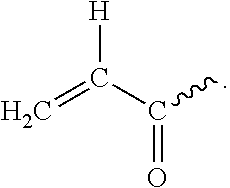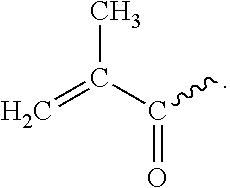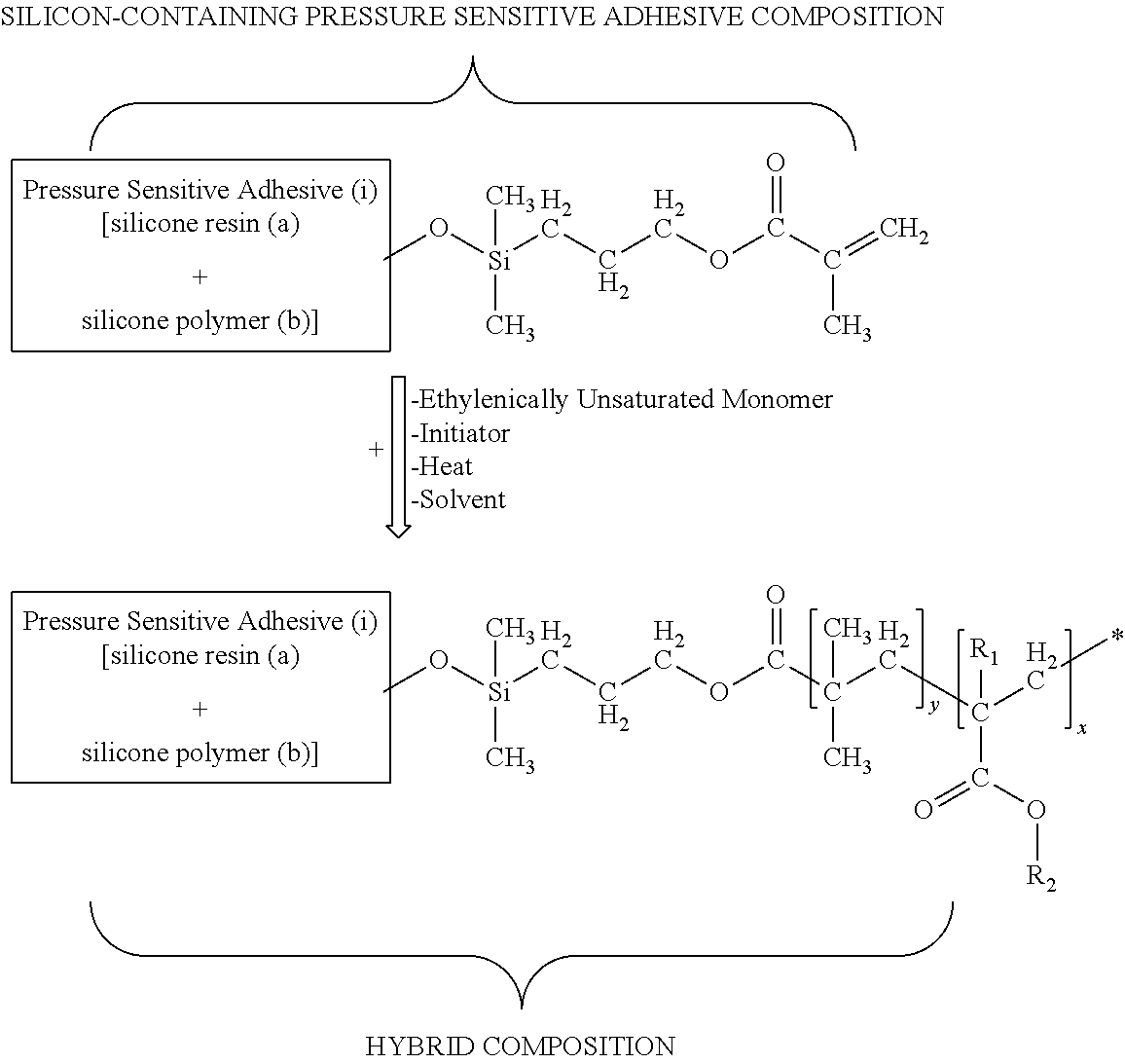Silicone acrylate hybrid composition and method of making same
a technology of silicon acrylate and hybrid composition, which is applied in the direction of drug compositions, immunological disorders, metabolism disorders, etc., can solve the problems of poor low temperature performance, poor high temperature performance, and inability to adhere to surfaces with low surface energies, and achieve the effect of greater flexibility
- Summary
- Abstract
- Description
- Claims
- Application Information
AI Technical Summary
Benefits of technology
Problems solved by technology
Method used
Image
Examples
example 1
Dichloro-Functional Capping Agent (Z=2)
[0135]To a 32 ounce jar, 811.0 g of PSA 1 and 4.8 g of CA 1 are added. The generation of HCl is immediate as indicated by pH paper color change. The material is allowed to mix overnight on a mixing wheel. The next day 100 g of sodium bicarbonate is added to the material to aid in the neutralization of the HCl. Then the material is allowed to mix overnight. The material is then pressure filtered the next day to remove particulate. The resulting non-volatile content for the material is 60.56%.
example 2
Trichloro-Functional Capping Agent (Z=3)
[0136]To a 32 ounce jar, 831.0 g of PSA 1 and 5.0 g of CA 2 are added. The generation of HCl is immediate as indicated by pH paper color change. The material is allowed to mix overnight on a mixing wheel. The next day, 100 g of sodium bicarbonate is added to the material to aid in the neutralization of the HCl. The material is allowed to mix overnight. The material is then pressure filtered the next day to remove particulate. The resulting non-volatile content for the material is 62.12%.
example 3
Using Dichloro-Functional Capping Agent (Z=2) of Example 1
[0137]To a 16 ounce jar, 44.5 g of 2-EHA, 19.4 g of MA, 104.5 g of Example 1, 10.5 g of ethyl acetate solvent and 0.091 g of Vazo® 67 are added to form a pre-reaction mixture. The materials in this pre-reaction mixture are allowed to stir 15 minutes until thoroughly homogeneous. After mixing, 42.3 g of the pre-reaction mixture and 123.6 g of ethyl acetate solvent are added to a 4-neck glass reactor equipped with a heating mantle, stifling blade / shaft, nitrogen purge, condenser with cooling water and a thermocouple. The remaining portion of the pre-reaction mixture is added to a separate pear-shaped glass reservoir. Heating and mixing is then begun on the mixture in the reactor. The reaction temperature is set at 78° C. As soon as the reaction temperature is achieved, the mixture is allowed to react for 60 minutes prior to adding more of the pre-reaction mixture to the reactor. Once 60 minutes elapsed, the mixture in the reser...
PUM
| Property | Measurement | Unit |
|---|---|---|
| viscosity | aaaaa | aaaaa |
| temperature | aaaaa | aaaaa |
| Tg | aaaaa | aaaaa |
Abstract
Description
Claims
Application Information
 Login to View More
Login to View More - R&D
- Intellectual Property
- Life Sciences
- Materials
- Tech Scout
- Unparalleled Data Quality
- Higher Quality Content
- 60% Fewer Hallucinations
Browse by: Latest US Patents, China's latest patents, Technical Efficacy Thesaurus, Application Domain, Technology Topic, Popular Technical Reports.
© 2025 PatSnap. All rights reserved.Legal|Privacy policy|Modern Slavery Act Transparency Statement|Sitemap|About US| Contact US: help@patsnap.com



